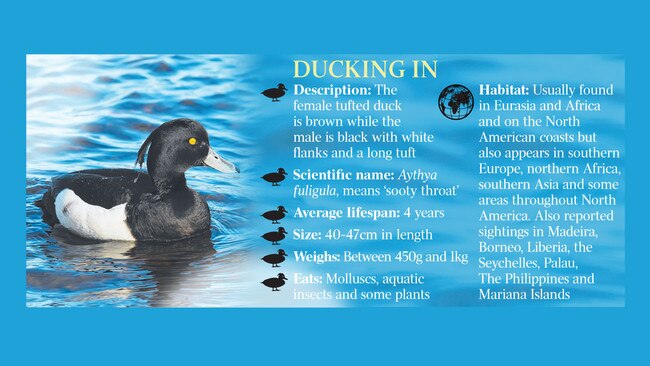Birdwatchers flock to Werribee sewage farm to see Tuffy, the tufted duck
Sydney man Stephen Aveling-Rowe drove 850km to Victoria to see a rare tufted duck that only landed in Australia because it was lost.

When Sydney bird watcher Stephen Aveling-Rowe heard that a tufted duck had been seen in Australia, he jumped in his car and headed 850km down the Hume Highway to Werribee, in Melbourne’s west, where the never-before-seen-in-Australia Eurasian duck has touched down at a sewage treatment centre.
Mr Aveling-Rowe, 20, said while he’d seen tufted ducks in Europe on birdwatching trips, the chance to see one in Australia was incredible.
“Considering it's a first record for Australia, it doesn’t get much better than that.” he said.

Mr Aveling-Rowe is just one of hundreds of bird watchers flocking to Victoria for a chance to see the lone tufted duck — nicknamed Tuffy — that has made its debut Australian entrance at the Western Treatment Plant in the outer western Melbourne suburb of Werribee.
The small diving bird is native to northern Eurasia but can be found across Europe, in the US and in southern Asia.
Avid birdwatcher James Mustafa said Tuffy (Aythya fuligula) has probably already attracted up to a thousand admirers, around of half of which travelled interstate for the privilege to spy the lucky duck.
“Birding and twitching is a little like real life Pokemon,” he said. “You try and collect as many as you can.” he said.
Birder is a colloquial term for a birdwatcher while a twitcher is someone who will travel long distances for the chance to tick another species off their bird watching list.

Sean Dooley, editor of birdlife Australia, said while new birds were increasingly landing in the far north of Australia due to habitat destruction in countries like Indonesia as well as the effects of climate change, they usually landed in areas like the Kimberley or on Christmas Island.
“It’s a pretty big deal,” he said.
Mr Dooley said Tuffy probably got lost, overshooting its intended destination by some several thousand kilometres.

“Most likely something’s gone wrong with its internal GPS and its just kept going south.”
“For whatever reason and it’s just kept coming south and its found its way to the Werribee sewage farm.”
The Western Treatment Plant is one of the most popular spots for birdwatching in Victoria with ACTU Secretary Sally McManus a fan.
More than 280 species can be found at the Western Treatment Plant, thriving on the clean water supply and abundance of food without interference from humans. As the land is owned by the government, hunting is forbidden.
Local bird expert Bruce Richardson said while Tuffy was currently the only tufted duck in Australia, it was possible the duck could breed with the local hard duck species.
“Ducks are known in general to be … I don’t want to say promiscuous … but possibly not quite as choosy as some other species of birds here, so you never know.” he said.


